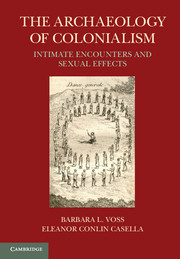Book contents
- Frontmatter
- Contents
- List of Illustrations
- List of Tables
- List of Contributors
- One Intimate Encounters
- Two Sexual Effects
- Section I Pleasures and Prohibitions
- Section II Engaged Bodies
- Seven Fear, Desire, and Material Strategies in Colonial Louisiana
- Eight Death and Sex
- Nine Effects of Empire
- Ten In-between People in Colonial Honduras
- Eleven The Scale of The Intimate
- Section III Commemorations
- Section IV Showing and Telling
- Conclusion
- Index
- References
Eight - Death and Sex
Procreation in the Wake of Fatal Epidemics within Indigenous Communities
from Section II - Engaged Bodies
Published online by Cambridge University Press: 05 June 2012
- Frontmatter
- Contents
- List of Illustrations
- List of Tables
- List of Contributors
- One Intimate Encounters
- Two Sexual Effects
- Section I Pleasures and Prohibitions
- Section II Engaged Bodies
- Seven Fear, Desire, and Material Strategies in Colonial Louisiana
- Eight Death and Sex
- Nine Effects of Empire
- Ten In-between People in Colonial Honduras
- Eleven The Scale of The Intimate
- Section III Commemorations
- Section IV Showing and Telling
- Conclusion
- Index
- References
Summary
Engagement of indigenous people in the enterprise of European colonialism in the Americas is usually conceived as part of a process that transpired wholly within the sphere of direct interaction between native and nonnative people. Yet anthropological focus on economic relationships with fur traders, native labor in the fields and mines of a world system, or voluntary or forced participation of indigenous people in religious missions may overlook potentially profound social effects elsewhere. Native social change initiated by the colonial venture also occurred within traditional indigenous communities located in areas at great distances from colonists and in situations that entailed little or no direct interaction with Europeans. In addition, the changes in these settings involved not only economic, political, or ideological shifts but also likely encompassed diverse social interactions within groups, including challenges to, or changes in, the intimate relationships and sexual practices of indigenous people.
Such shifts may be anticipated, in part, because of native catastrophic depopulation brought about by down-the-line transmission of introduced Old World diseases and resultant fatal epidemics. That is, sexual practices may have been altered to respond to the reproductive priorities supported by such liaisons. Still, the renegotiation of sexual roles, mores, and practices within native communities of the colonial hinterland remains unexplored, even as the sexual and reproductive consequences of colonialism in institutional settings or across landscapes that were physically or socially dominated by European interlopers have been at least initially examined by anthropological archaeologists, especially with respect to intermarriage (e.g., Deagan 1983; Lightfoot et al. 1998; Voss 2008; Woodhouse-Beyer 1999). Given the scale of population decline within native communities during the colonial era and, especially, the initiation of such processes in areas beyond the view of literate observers, it is important for archaeologists to turn their attention to this arena of the colonial “encounter” as well and explore the social and cultural consequences that such events may have precipitated. To understand the subsequent course of native cultural resistance or change expressed in sexual encounters with European people, we must first appreciate the challenges already faced and modifications already underway within these communities before face-to-face interaction.
- Type
- Chapter
- Information
- The Archaeology of ColonialismIntimate Encounters and Sexual Effects, pp. 122 - 137Publisher: Cambridge University PressPrint publication year: 2011
References
- 2
- Cited by

